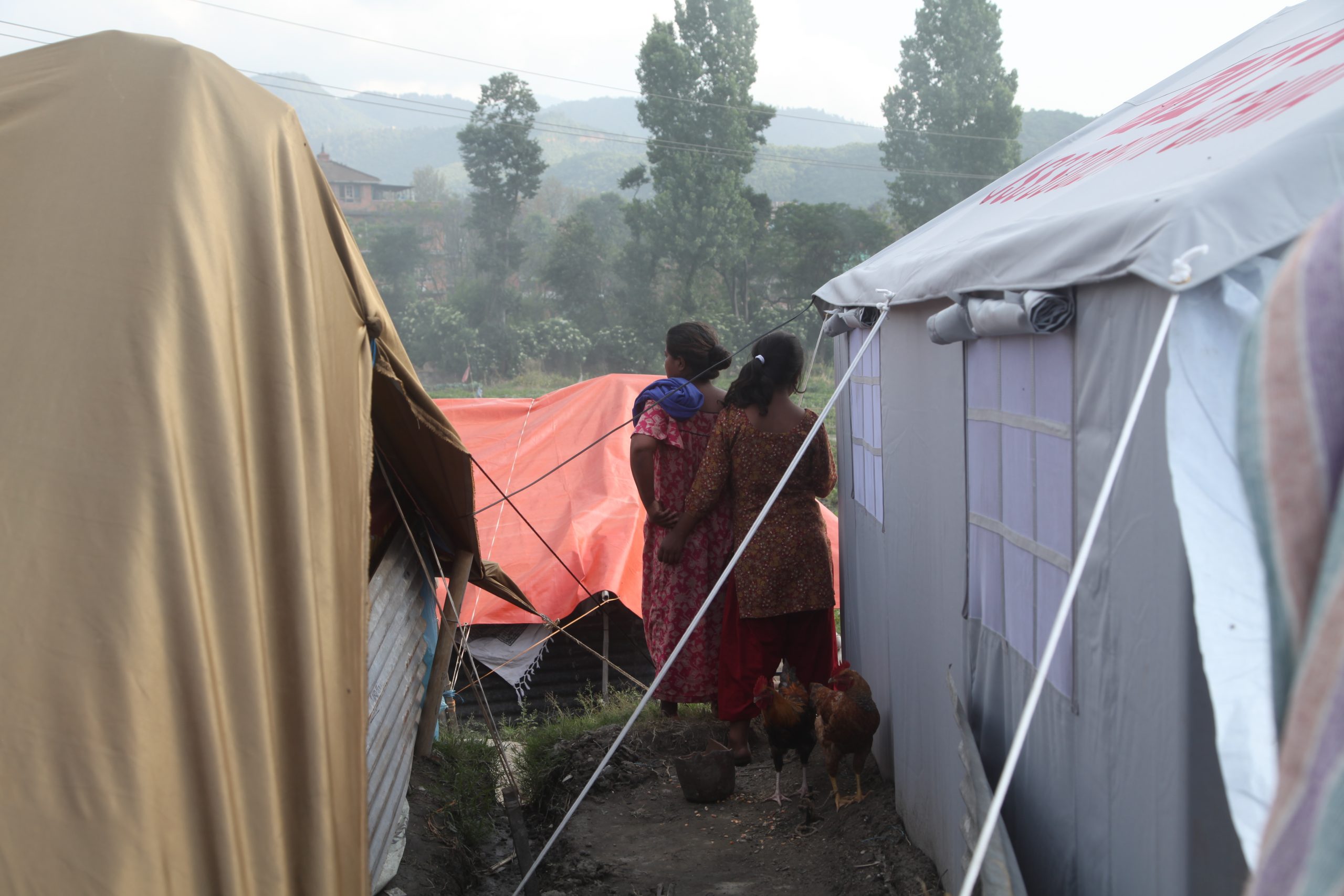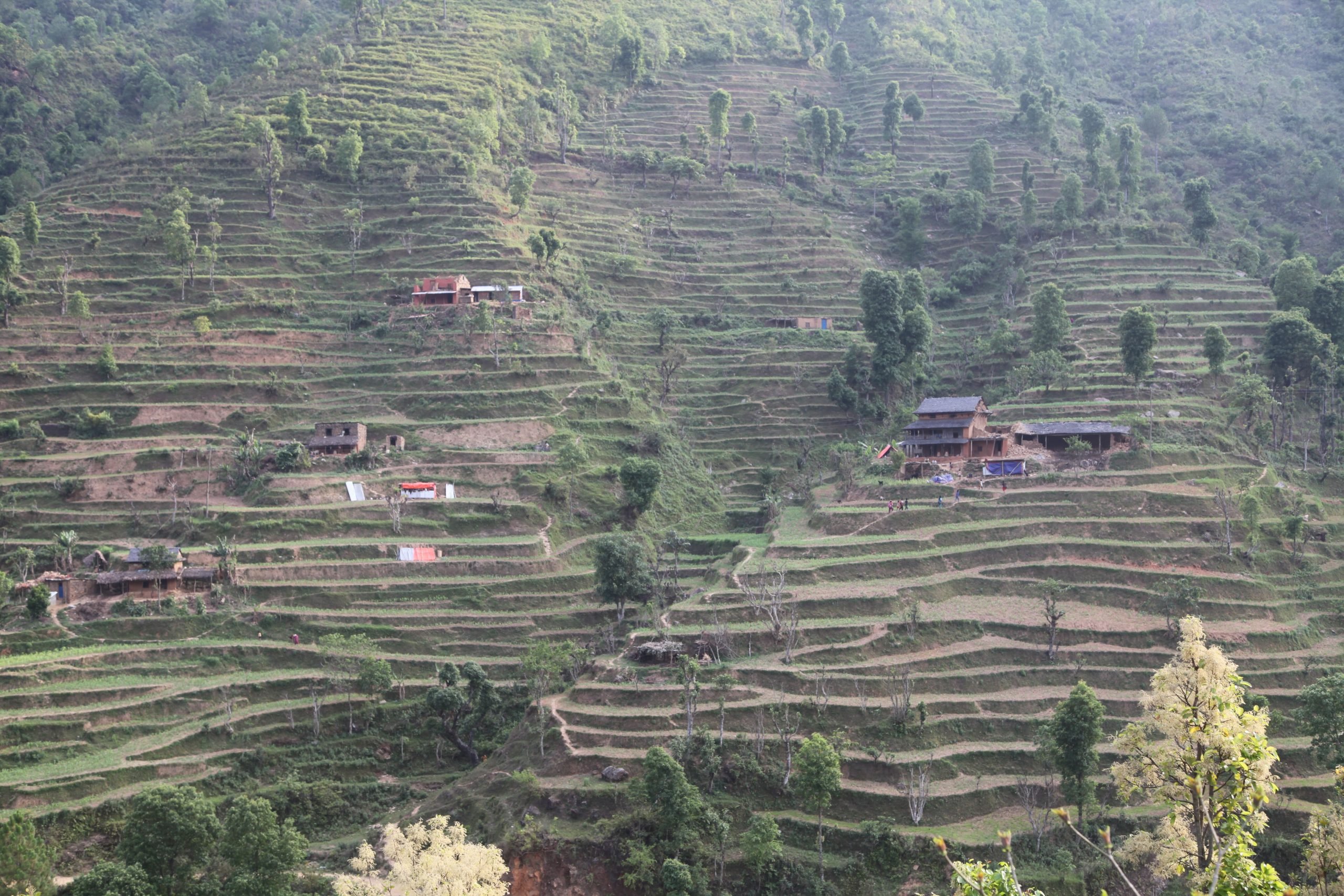Nepal after the recent earthquakes: reconstruction and vaccine-preventable enteric diseases
In the wake of the recent devastating earthquakes, PLOS Medicine Consulting Editor Lorenz von Seidlein visited Nepal to assess outbreak risks. Lorenz travelled with Anuj Bhattachan, International Vaccine Institute, Seoul, Korea and guidance from Deepak C. Bajracharya and Shyam Raj Upreti from the Group for Technical Assistance, Kathmandu, Nepal. The assessment was requested by the epidemiology and disease control division of the Ministry of Health of Nepal and facilitated by Stop Cholera. Here he reports on the damage he witnessed and considers the choice of administering vaccines pre-emptively versus reactively in response to an outbreak.

The two earthquakes in April and May 2015 seem to have selectively erased much of northern Nepal’s architecture and history. Many buildings in urban Kathmandu were constructed during the last 20 years. These buildings, in many cases multi-storey or high-rise, did not collapse during the recent earthquakes. The older buildings in urban Kathmandu are brick and mortar constructions without a frame. These vintage structures give Kathmandu its characteristic charm but they fell like dominoes during the first earthquake on 25th April. In rural districts the buildings are mostly stone and clay; they are perfectly adapted for the high altitude climate of the Himalayas but offer very little resistance against an earthquake. Most of the stone houses completely crumbled or have large enough cracks to suggest imminent collapse. According to government figures, 488,579 houses were destroyed and 260,026 damaged. The probability of a quick reconstruction is small because of the widespread damage. Furthermore, majority of men of working age are employed abroad, leaving a denuded local labour force.1
Current estimates suggest that 8,151 people died and some 17,866 people were injured in the two quakes. Currently most health care is required for acute trauma but trauma will be replaced by other presentations during the coming months. Water resources of the 660,000 to 1.3 million people were affected and between 850,000 to 1.7 million need sanitation support. Concurrently 945 health facilities, mostly village health posts, are partially or totally damaged. Health services have been severely compromised. Routine childhood vaccinations had to be suspended in some districts. The makeshift temporary living conditions, disruptions to water supply and sanitation, and strained health services foreshadow an aftershock of a different variety: enteric diseases may seize this opportunity to spread through an already devastated country.

Two vaccine preventable enteric diseases are endemic in Nepal and have potential for outbreaks. Kathmandu is considered by some the typhoid fever capital of the world. The transmission of the typhoidal Salmonella species is facilitated by poor hygiene and public sanitation conditions. Although the Vi polysaccharide typhoid vaccine was found to be safe and effective in clinical trials in Nepal in 1987, to this day immunization against typhoid fever has not been included into the country’s public health armamentarium.
Cholera is another enteric disease endemic in Nepal that has a high outbreak potential. The largest recent cholera outbreak in Nepal occurred in Jajarkot district in 2009. More than 30,000 reported cases and 500 cholera deaths were reported during the outbreak in Jajarkot and surrounding areas in 2009. In 2014 a cholera outbreak was reported in Rautahat district in the low altitude region of Nepal bordering India. In response the MoH undertook a vaccination campaign with oral cholera vaccine (OCV) which has become available through a stockpile mechanism administered by the WHO. This mechanism allows countries to quickly obtain low-cost vaccines including OCV, meningococcal and yellow fever vaccine.
There are some mitigating circumstances which could reduce the risk for cholera outbreaks. For example, the landslides, which have made access to the northern villages impossible, also likely prevent importation of cholera into these remote villages. During our assessments of areas outside Kathmandu, we witnessed helicopter deliveries of food and basic medicines by airdrops. On the other hand, should a cholera outbreak occur in these isolated areas, it may take weeks before it is detected and a response mounted. Such delays will result in high case fatality rates.
The availability of a safe and protective vaccine against cholera has raised a debate whether OCVs should be used reactively (in response to an outbreak) or pre-emptively (to prevent an outbreak) during the post-earthquake period in Nepal. Of course prevention is smarter, but the damage is widespread; who should receive the vaccine? Predicting where a cholera outbreak will occur remains impossible, the total amount of OCV on the world market is limited, the population currently at high risk for cholera secondary to the earthquake is much larger than the available product, and the vaccine and its administration costs money.
Most importantly, large vaccination campaigns are more technically challenging during the aftershocks of a massive earthquake and in isolated areas where access is difficult. Earlier this week we visited a district health officer in Gorkha— one of the most severely affected districts— who had no time to talk with us. When he finally had two minutes available, he told tell us that he is overwhelmed by the demands of disaster management, there are (at the moment) no cholera cases in his district, and a cholera vaccination campaign was simply not on the cards. A range of emergency measures had precedence on this day and will have precedence in the weeks to come. In the absence of evidence and experience policymakers are reluctant to select one community over another.

Reactive oral cholera vaccination seems to be the more feasible alternative if the detection of cholera cases and an immediate response can be guaranteed. Reactive vaccinations rely on accurate and complete surveillance. The current Nepalese cholera surveillance protocol demands the immediate reporting of suspected cholera cases (i.e. watery diarrhoea) by the health posts to the district health centre, which are then forwarded to national health laboratory, which will send transport media for sample collection to the affected health post and return the samples to the laboratory. The results are reported to the MoH, which takes appropriate action. That this process can fail was demonstrated in Jajarkot district in 2009 when no earthquake had happened. Cholera cases have to be detected rapidly for timely measures (case management, water supply, sanitation, hygiene education as well as vaccination) to be put in place. Oral cholera vaccination campaigns will require the completion of paperwork, approval by an international coordinating group, shipment of vaccines, planning and implementation of a vaccine campaign. Under optimal circumstances this process can take two months. Circumstances in Nepal are currently not optimal for a rapid response. If a cholera epidemic is progressing slowly, a linear increase in the number of new cases can be manageable. If the number of cases increases at an exponential rate, the containment of the outbreak is unlikely and a catastrophic outbreak similar to the cholera outbreak in Zimbabwe 2008-2009 or Haiti 2010-2011 is the more likely scenario.
There is no easy solution. At the moment the path of least resistance is to ramp up surveillance as much as possible to be able react to an outbreak as quickly as possible. Considering the current circumstances, the shocks to the health care system, and the priority for reconstruction nobody will object to such an approach. Yet if this plan doesn’t work out and cholera spreads we will regret the decision not having acted pre-emptively. Indeed the majority of mass cholera vaccination campaigns have been pre-emptive. Considering the damage and the suffering caused by the recent large cholera outbreaks in Zimbabwe and Haiti a large pre-emptive campaign may be the best solution for Nepal.
1- It has been estimated that remittances from this mobile workforce made up 29% of the GDP of Nepal in 2013. During a visit to heavily affected villages in Dhading and Gorkha on 14th and 15th May 2015 we encountered mostly women and children.

[…] In the wake of the recent devastating earthquakes, PLOS Medicine Consulting Editor Lorenz von Seidlein visited Nepal to assess outbreak risks. Lorenz travelled with Anuj Bhattachan, International Vaccine Institute, Seoul, Korea and guidance from Deepak C. Bajracharya and Shyam Raj Upreti … Continue reading » […]
This report has been a great tool to know about the extent of damage due to Earthquake and the possible disease outbreaks, particularly Cholera.
Considering the history of outbreaks in Jajarkot in 2009 and the delays in reactive treatment and prevention by Ministry of Health, it seems urgent to implement pre-emptive implementation of Cholera vaccination. In addition, the Jajarkot Cholera happened when there was no Earthquake, and yet the containment was challenging. To wait for a reactive vaccination especially during this disaster period is simply to wait for insurmountable challenges especially as rainy season is approaching soon. Rainy season in normal condition has always brought water and sanitation related diseases every year.
Therefore, why not, foresee the future, initiate a smart move and implement pre-emptive vaccination for Cholera ?
Lorenz gives a very clear account on the ground level situation as seen by a technical expert. Most of the information currently coming out of Nepal are through journalists, which lack details. Few useful letters are seen in the Pro-med mail.
As expected, the priority is now on immediate concerns on shelter, food and water. Most officials are overwhelmed with this work. This piece is also quite informative -http://adventureblog.nationalgeographic.com/2015/05/20/aid-worker-in-nepal-now-is-the-calm-before-the-storm/
The real health crisis can be expected to arrive at about one week after the start of monsoons (rains). Today, (22.May.2015) monsoon winds have reached the shores of south Sri-lanka. By about 1st June (or before), it is expected to reach the southern tip of India (Kerala) and then move north-wards to reach Nepal by mid-June. Planning for health should target the eventualities from mid-June. On vaccine preventable diseases, along with Cholera, measles too needs to be considered. Acute diseases which require attention include pneumonia (viral, bacterial and combined), cholera and other diarrhoeal diseases, enteric fever, dysentry, viral hepatitis, dengue, malaria, viral encephalitis, murine typhus, scrub typhus, and leptospirosis. The last three require special attention. These diseases have been documented as to be present in large numbers in Nepal but significantly under-reported. In other words, the doctors there are not able to suspect these diseases on clinical grounds and the testing facilities would be extremely limited, even in good times. (See references below). Leptospirosis would easily be misdiagnosed as hepatitis and consequently mismanaged. Easily treatable typhus can become a deadly disease. Additionally, preparations should be done to handle dog bites, snake bites and worm infestations.
1. Murdoch DR, Woods CW, Zimmerman MD, Dull PM, Belbase RH, Keenan AJ, Scott RM, Basnyat B, Archibald LK, Reller LB. The etiology of febrile illness in adults presenting to Patan hospital in Kathmandu, Nepal. Am J Trop Med Hyg. 2004 Jun;70(6):670-5.
2. Thompson CN, Blacksell SD, Paris DH, Arjyal A, Karkey A, Dongol S, Giri A, Dolecek C, Day N, Baker S, Thwaites G, Farrar J, Basnyat B. Undifferentiated febrile illness in kathmandu, Nepal. Am J Trop Med Hyg. 2015 Apr 1;92(4):875-8. doi: 10.4269/ajtmh.14-0709. Epub 2015 Feb 9.
I agree with Dr. von Seidlein and Bibin Adikharis’ comments that the best way to avoid an outbreak, along with instituting well known Wash measures, is to do pre-emptive OCV vaccination for those in the most devastated, at-risk circumstances, such as has been done in other disaster and refugee communities and camps. In a country that has endemic cholera, regular outbreaks and is facing the monsoon in conditions of a greatly-damaged infrastructure, pre-emptive vaccination is critical. The challenge is to map out the communities and populations at greatest risk and estimate the amount of vaccine needed, because of the limited supply of vaccine. Given the timing and circumstances, it’s important to start this effort right away. It will not be easy given the widespread nature of the earthquake and Nepal’s mountainous terrain, but there are focal areas that need to be considered. It is also important to prepare for potential outbreaks.